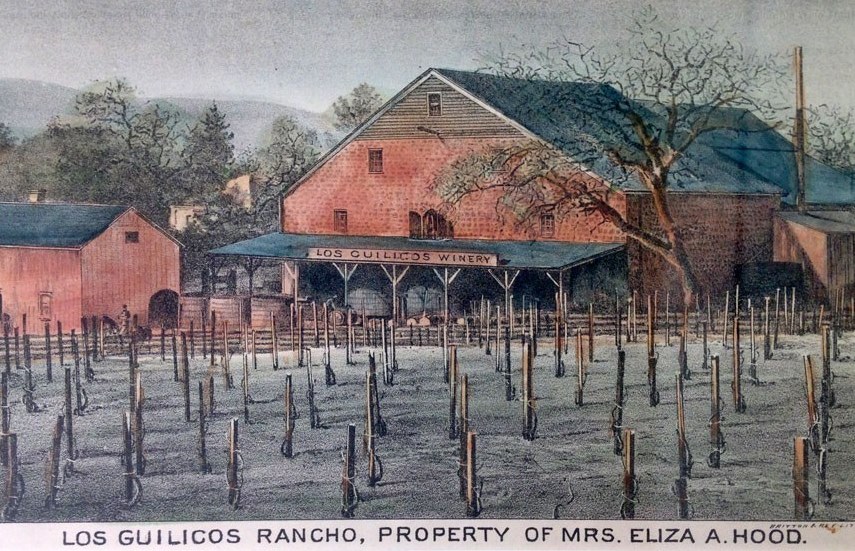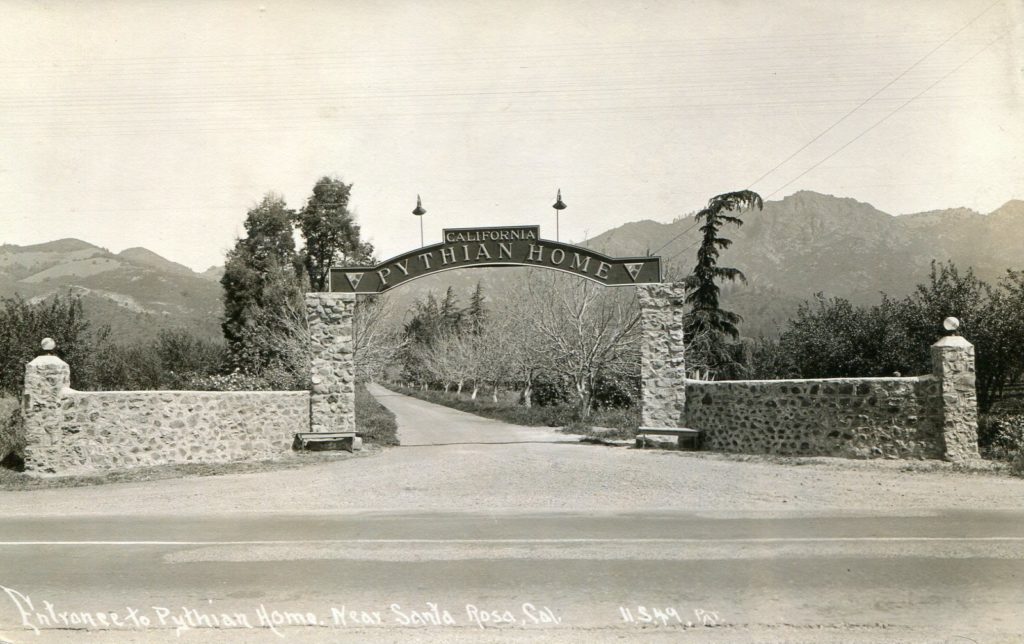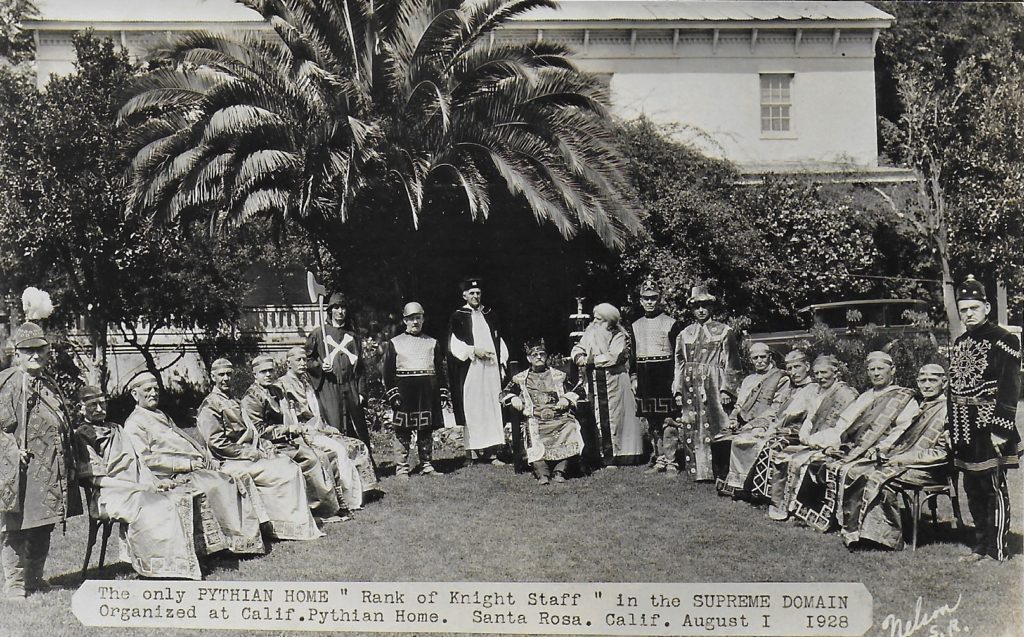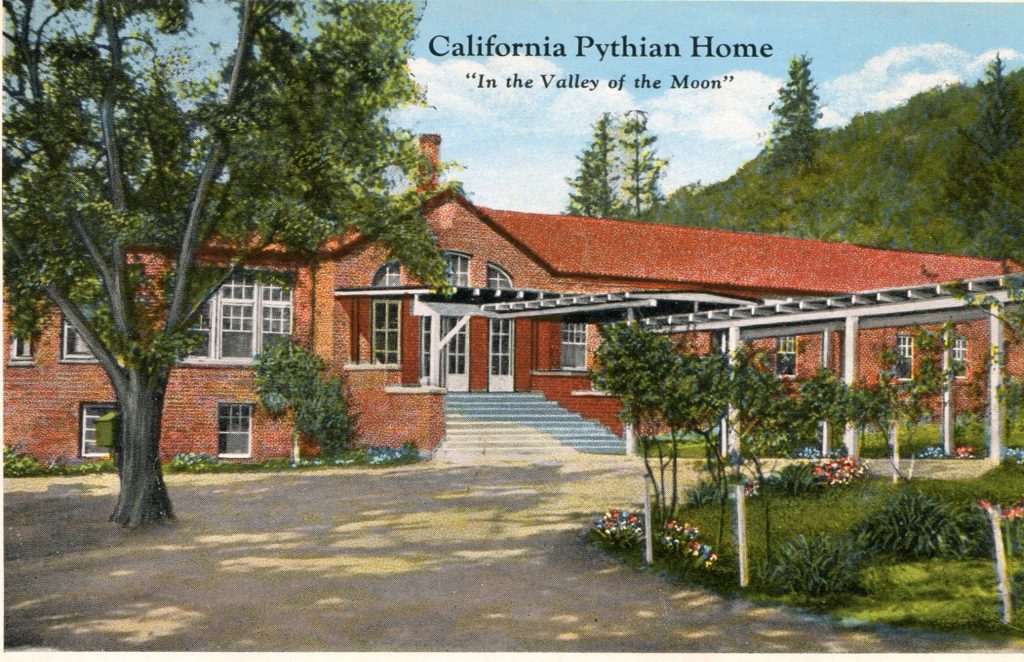Before October 2020, some may have thought of the Hood House, constructed in 1858, for its proximity to the temporary shelter site known as Los Guilicos Village. Or perhaps know of the landmark property from attending a Funky Fridays @ The Hood concert. Because of the Glass fire, there is now an increased awareness of this county-owned property – a property rich in architectural and agricultural history worth preserving.

The Hood House is a two-story brick structure that is listed on the National Register of Historic Places. The surrounding property has hosted various institutional uses over the last 75 years, but before 1943 it was a hub of agriculture production in the Sonoma Valley.
William Hood purchased a portion of the Rancho Los Guilicos in 1850 from General Vallejo’s brother-in-law, Juan Wilson. Within a few years, Hood had planted a vineyard and was harvesting wheat, oats, and hay.
In 1855 Hood married 14-year-old Eliza Shaw, the daughter of a neighbor, who he sent to his native Scotland to be educated. While Eliza was away, William built the original 15 room Hood House.
According to the 1860 census, livestock on the Hood property included 200 horses, 26 mules, 40 milch cows, ten oxen, 2,000 sheep, 20 swine, and 800 head of cattle.
To pay off debts, the Hoods sold much of their holdings in the late 1860s. On the remaining acreage, they raised horses, harvested fruit and grain, and established the Los Guilicos Winery. In 1870, the ranch produced 15,000 gallons of wine and 2,500 gallons of brandy.

During the mid-1870s, frost destroyed nearly all of the vineyards on the Hood Ranch. Eliza Hood took over management of the estate after William became ill in 1877. Eliza was declared a sole trader by the Superior Court of Sonoma County in 1880 and secured her legal authority to run the ranch independently. In the early 1880s, Eliza purchased back 1,300 acres of her land and, by 1885, had 250 acres planted in grapes and was shipping wines to markets in Europe and making brandy.
By 1888, Eliza Hood was able to ship her wines via the Santa Rosa and Carquinez Railroad, a subsidiary of the Southern Pacific. With a terminal rail yard in Santa Rosa, this line traveled through the Valley of the Moon and Sonoma, then through Shellville and east across the northern San Francisco Bay wetlands connecting with the national rail network at Napa Junction. This railroad avoided the ferries of San Francisco Bay. It provided a direct link to eastern markets for agricultural products of Sonoma County, including those from the Hood Ranch, which had its own depot.
On November 19, 1893, the San Francisco Call lauded Eliza Hood as one of several successful women ranchers operating in California.
Despite improved means of transportation and favorable publicity, financial problems continued to plague Eliza. In June of 1895, she sold all the wine in her cellars, over 210,000 gallons, to E. Garnier & Company of San Francisco. The ranch went into foreclosure, and Francis S. Wensinger purchased Eliza’s property at a sheriff’s sale.
Eliza then moved to San Francisco and ran a boarding house out of her California Street home, where she resided until her death in 1914. William Hood died in 1903 at the Mendocino State Asylum for the Insane in Talmage.
Francis Wensinger’s widow, Teresa, sold the Hood Ranch in 1905 to Thomas Kearns, a former Utah senator, and millionaire.

The Santa Rosa Republican quoted Kearns as proclaiming that it was the “splendid climate, and the electric railways sweeping across the hills and threading the valleys, along with the municipal advancements of the cities” that convinced him to “buy a foothold” in the Los Guilicos valley.
Kearns increased the ranch’s acreage and enlarged the Hood House. Many grand parties were held on the property and attended by prominent society members, including, some say, Theodore Roosevelt and William McKinley.
Five months before his death, Kearns sold the ranch to an English merchant, Peter O. Serck. Newspapers reporting on the sale described the property as one of the most picturesque and valuable in Sonoma County, containing some of the highest quality fruit, grain, and cattle land around.

Postcard created by Frank Patterson, aka Pat
The Knights of Pythias purchased 1,300 acres in 1924. At the time of purchase, the ranch consisted of 36.3 acres planted with two and three-year-old prunes, 14.9 acres planted in three and four-year-old peaches and apricots, 102.9 acres in grapes (Zinfandel and Alicante Bouschet, full bearing), 162.5 acres in hay, and 70 acres in grain.
The Knights of Pythias had long considered this site for a retirement community and orphanage for their members. In 1925 they commissioned local contractor Albert Hildebrand to construct a 27 room dormitory, the first of several brick structures designed in the Spanish Revival style. They also envisioned a “Mecca for California Pythians who traversed the state’s highways on vacation tours” and set aside several acres for campsites and picnic areas.

The Pythian Home was largely self-sufficient. The chicken ranch occupied about five acres and accommodated 6,000 hens. The following excerpt from the Hood House National Register nomination was shared by Harry W. Hellman, an orphan, and former resident:
[The Home] raised much of their own beef and pork; milk from their dairy took care of all their needs. There was also a chicken ranch on the property which supplied all of the eggs and chickens we needed for the Home operation. The Home also sold several thousand dollars worth of eggs to the Poultry Producers annually.All the grain to feed the livestock was home grown. Corn was also raised and filled the two silos used to feed the stock during the winter. Angora goats were brought in [to supply] needed meat as well as being sheared annually for their wool.
A number of acres were devoted to the Muir Peach as well as many acres of prunes which both were dried and [packaged] and sold through our Pythian Lodges. . . Walnut and fig trees lined the drive from the highway to the Home and these two were harvested annually. There were two reservoirs on the property [and] a deep well which supplied all the water needed for irrigation and domestic use. . .
National Register of Historic Places Nomination Form, William Hood House, prepared by Michael Buhler, 1997.
In 1943 the Knights of Pythias and Pythian Sisters of California closed the doors to the Pythian Home and farm at Los Guilicos.

The Pythians sold to the State of California, who repurposed the Hood House and Pythian era brick buildings and site for the California School for Girls. The school operated into the 1970s when the County of Sonoma purchased it.
Over the past 40 years, the County has utilized this property for various purposes, including a juvenile detention center, storage for archival materials, the Sierra Girls Garden Center, shelter, classrooms, and public safety training facilities.
Assessment of the financial impact of the Glass fire is underway. What happens next is uncertain, but an appreciation for the property’s architectural and agricultural history will hopefully inform future land-use decisions.
A version of this article appeared in the November 2020 Sonoma-Marin Farm News, a publication of the Sonoma County Farm Bureau.
Notes:
Research assistance provided by Arthur Dawson, Baseline Consulting, who kindly shared his 2019 unpublished “Hood House Timeline.”
I also relied on Vicki Beard’s 2006 Architectural and Historical Evaluation of the Los Guilicos Juvenile Justice Center Complex – Pythian Road, Sonoma County, Calif., that is on file at the Sonoma County History & Genealogy Library and available via the Internet Archive.
 Sonoma County’s First Breweries
Sonoma County’s First Breweries
Very interesting! Thank you for this informative and fascinating history of Los Guilicos.
I’m glad you enjoyed it.
KUDOS! This is such an informative, well researched and written article. I learned a lot more about this Sonoma County landmark property. Thank you Katherine.
You’re most welcome. Thank you for putting me in touch with Dean Walters! That color image really added a lot to the story. Next up will be “The History We Nearly Nost at Los Guilicos” Part II – where I’ll talk about the Sonoma County Archives. Stay tuned.
Thank you for sharing this article, Katherine. I obviously have a special interest in this property!
You’re most welcome. Someday I’m hoping we can have that “Holidays at the Hood” event we’ve talked about:)
I grew up in East Santa Rosa. My parents were devote Catholics.We as a family of six children would attend Mass at the School for girls, with Father Cletius Kern as the Priest. I was in elementary School at St.Eugene’s.Those young girls fascinated me, as they were not like my older sisters.Many thanks for the memory jog and such a detailed account of Hood House orginal family.
What does Guilicos mean? My Spanish dictionaries don’ list guilicp
According to Erwin G. Gudde’s California Place Names: The Origin and Etymology of Current Geographical Names (4th Edition) “Guilicos is from Lake Miwok wiilok “dusty” (Callaghan) plus the Spanish masculine plural suffix – os. This is the name of a land grant dated November 13, 1837; it was derived from the name of an Indian tribe, mentioned on April 10, 1823, by Padre Amoros as la nacion Guiluc. The name appears repeatedly in mission records, with various spellings.”
Genuinely nice article Katherine! I learned a lot more about the Pythians. I wonder why they left in 1943.
Hi Ray – Thank you. The Knights of Pythias connection is so interesting, yet not widely known. As to why they sold in 1943 – the need for retirement homes of this type had lessened. A combination of declining membership and the introduction of social security benefits may have been factors. Further research needed:)
Great article! When Kearns bought it in 1905, he hired noted architect William H. Willcox to modernize and double the house in size. Exterior and interior photos here:
http://santarosahistory.com/wordpress/2011/11/is-it-hood-mansion-or-hood-house/
Hi Jeff – Thank you. I had come across your blog about Wilcox. So many stories associated with this property – many of which were revealed when we visited the Hood House together all those years ago – a visit you coordinated. Thank you for that.
Oh, I forgot you were along on that trip! What a house, eh? I later found out that Kearns’ beautiful oak furniture (including the 14-foot dining room table) was made by Santa Rosa master craftsman Frank S. Smith. A couple of years later he also did a complete living room and reception hall set for pharmacist Hahman and his family at 718 McDonald Ave. The interesting angle to that is the furniture was intended to harmonize with their Arts & Crafts house which was designed by Brainerd Jones.
This is a great story! Thanks for all the details. I do love Funky Fridays and hiking the hills in the park. Would it be possible for me to share this with our Native Daughters? I could add it to our FB page or send it as an email to our members. We are an eclectic group of passionate CA history lovers!
Well done!!
Hi Mary – I’d be delighted to have you share with the Native Daughters and anyone else you think might find it of interest.